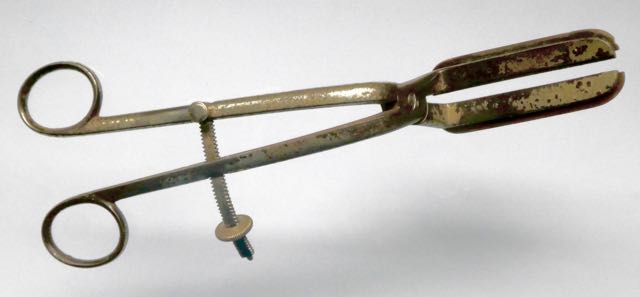|
Treating bleeding haemorrhoids for a long time was not a matter of course, emptying the body of decayed blood. As late as the eighteenth century this was due to a number of morbid conditions: "The flowing golden vein sometimes keeps its proper time, and appears every few months, in which case it is always to be regarded as a salutary emptying, which in no way must be clogged in the podagra and other gouty diseases, in shortness of breath, and in hypochondriacal incidents salutary "(Onomatologia Medico-Practica: Encyklopädisches Handbuch für practicing physicians, Nuremberg 1784 p.1034).
In the nineteenth century, the attitude of the doctors changed, and accordingly a number of clamps were developed, with which one could grasp internal haemorrhoidal nodules with regard to their ligature or cauterization: in particular, the one that Bernard v. Chr. LANGENBECK (1810-1887) at the Berlin Charité and the one developed by Henry SMITH (1823-1894) at London's Kings College. The former was a pair of wing-tongs for grasping single pulled-out hemorrhoids. The latter clamp is presented here.
In 1876, in the 4th edition of his book "The Surgery of the Rectum," Henry SMITH (1823-1894) pinched. In the journal Lancet of April 20, 1878 (quoted in Charles B. Ball, The rectum and anus, Philadelphia 1887 p.270) he published the results thus generated.
Still in the catalog of the Waarenhauses Berlin from 1910 we find the "Hämorrhoidalknotenzange after Smith" with her ivory shoe.
For a long time I did not know why the foot of the clamp was covered with a (dark brown) horn until I found the explanation p.161 in the catalog of John Weiss & Sons (London / England): "with ivory guards for protection during cauterization" , Ivory isolates the surrounding tissue against the heat of the metal rod - not against electric currents, because at the time of SMITH it was mainly cauterized with the apparatus n. PAQUELIN, but not with electricity.
European brands had an ivory shoe - the colonies send their regards. In the US, where ivory was not so easy to use, the foot was made of horn - cattle were abundant in the endless prairies. Our Ocala / Florida imported tweezer (ebay) has no manufacturer's engraving except for a hallmark "43" (presumably a catalog number) and wears horn shoes (which have been nibbled in places by bugs). Horn but almost as well isolated as ivory ...
The problem of heat development during cauterization found other solutions. Thus, the surgeon at the Hôtel-Dieu in Paris Léon-Clément VOILLEMIER (1809-1878), who linearly cauterized the anal mucosa in 1873 with two knife-shaped annealing irons, coated the surroundings of the operating field with collodium "to ward off the radiant heat" (Wiener med. Wochenschrift 1873 P. 973)
|




